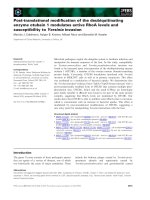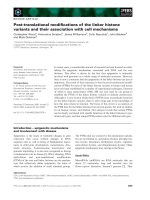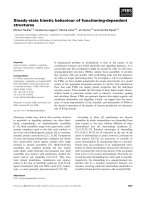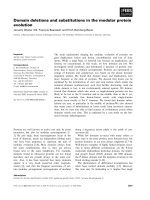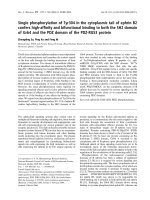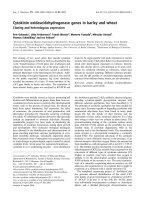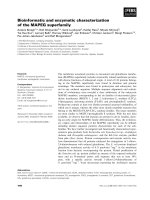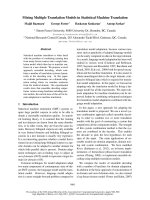Báo cáo khoa học: "Construct State Modification in the Arabic Treebank" doc
Bạn đang xem bản rút gọn của tài liệu. Xem và tải ngay bản đầy đủ của tài liệu tại đây (125.03 KB, 4 trang )
Proceedings of ACL-08: HLT, Short Papers (Companion Volume), pages 209–212,
Columbus, Ohio, USA, June 2008.
c
2008 Association for Computational Linguistics
Construct State Modification in the Arabic Treebank
Ryan Gabbard
Department of Computer and Information Science
University of Pennsylvania
Seth Kulick
Linguistic Data Consortium
Institute for Research in Cognitive Science
University of Pennsylvania
Abstract
Earlier work in parsing Arabic has specu-
lated that attachment to construct state con-
structions decreases parsing performance. We
make this speculation precise and define the
problem of attachment to construct state con-
structions in the Arabic Treebank. We present
the first statistics that quantify the problem.
We provide a baseline and the results from a
first attempt at a discriminative learning pro-
cedure for this task, achieving 80% accuracy.
1 Introduction
Earlier work on parsing the Arabic Treebank (Kulick
et al., 2006) noted that prepositional phrase attach-
ment was significantly worse on the Arabic Tree-
bank (ATB) than the English Penn Treebank (PTB)
and speculated that this was due to the ubiquitous
presence of construct state NPs in the ATB. Con-
struct state NPs, also known as iDAfa
1
(
) con-
structions, are those in which (roughly) two or more
words, usually nouns, are grouped tightly together,
often corresponding to what in English would be
expressed with a noun-noun compound or a pos-
sessive construction (Ryding, 2005)[pp.205–227].
In the ATB these constructions are annotated as a
NP headed by a NOUN with an NP complement.
(Kulick et al., 2006) noted that this created very
different contexts for PP attachment to ”base NPs”,
likely leading to the lower results for PP attachment.
1
Throughout this paper we use the Buckwalter Arabic
transliteration scheme (Buckwalter, 2004).
In this paper we make their speculation precise
and define the problem of attachment to construct
state constructions in the ATB by extracting out such
iDAfa constructions
2
and their modifiers. We pro-
vide the first statistics we are aware of that quantify
the number and complexity of iDAfas in the ATB
and the variety of modifier attachments within them.
Additionally, we provide the first baseline for this
problem as well as preliminary results from a dis-
criminative learning procedure for the task.
2 The Problem in More Detail
As mentioned above, iDAfa constructions in the
ATB are annotated as a NOUN with an NP comple-
ment (ATB, 2008). This can also be recursive, in that
the NP complement can itself be an iDAfa construc-
tion. For example, Figure 1 shows such a complex
iDAfa. We refer to an iDAfa of the form (NP NOUN
(NP NOUN)) as a two–level iDAfa, one of the
form (NP NOUN (NP NOUN (NP NOUN))) as
a three–level iDAfa (as in Figure 1), and so on. Mod-
ification can take place at any of the NPs in these
iDAfas, using the usual adjunction structure, as in
Figure 2 (in which the modifier itself contains an
iDAfa as the object of the PREP fiy).
3
This annotation of the iDAfa construction has a
crucial impact upon the usual problem of PP at-
tachment. Consider first the PP attachment prob-
lem for the PTB. The PTB annotation style (Bies et
2
Throughout the rest of this paper, we will refer for conve-
nience to iDAfa constructions instead of ”construct state NPs”.
3
In all these tree examples we leave out the Part of Speech
tags to lessen clutter, and likewise for the nonterminal function
tags.
209
(NP $awAriE
[streets]
(NP madiyn+ap
[city]
(NP luwnog byt$)))
[Long] [Beach]
Figure 1: A three level idafa, meaning the streets of the
city of Long Beach
(NP $awAriE
[streets]
(NP (NP madiyn+ap
[city]
(NP luwnog byt$))
[Long] [Beach]
(PP fiy
[in]
(NP wilAy+ap
[state]
(NP kAliyfuwrniyA)))))
[California]
Figure 2: Three level iDAfa with modification, meaning
the streets of the city of Long Beach in the state of Cali-
fornia
al., 1995) forces multiple PP modifiers of the same
NP to be at the same level, disallowing the struc-
ture (B) in favor of structure (A) in Figure 3, and
parsers can take advantage of this restriction. For
example, (Collins, 1999)[pp. 211-12] uses the no-
tion of a ”base NP” (roughly, a non–recursive NP,
that is, one without an internal NP) to control PP at-
tachment, so that the parser will not mistakenly gen-
erate the (B) structure, since it learns that PPs attach
to non–recursive, but not recursive, NPs.
Now consider again the PP attachment problem
in the ATB. The ATB guidelines also enforce the re-
striction in Figure 3, so that multiple modifiers of an
NP within an iDAfa will be at the same level (e.g.,
another PP modifier of ”the city of Long Beach”
in Figure 2 would be at the same level as ”in the
state ”). However, the iDAfa annotation, indepen-
dently of this annotation constraint, results in the PP
modification of many NPs that are not base NPs, as
with the PP modifier ”in the state ” in Figure 2. One
way to view what is happening here is that Arabic
uses the iDAfa construction to express what is often
(A) multi-level PP attachment at same level — al-
lowed
(NP (NP )
(PP )
(PP ))
(B) multi-level PP attachment at different levels —
not allowed
(NP (NP (NP )
(PP )
(PP ))
Figure 3: Multiple PP attachment in the PTB
(NP (NP streets)
(PP of
(NP (NP the city)
(PP of (NP Long Beach))
(PP in (NP the state)
(PP of
(NP California))))))
Figure 4: The English analog of Figure 2
a PP in English. The PTB analog of the troublesome
iDAfa with PP attachment in Figure 2 would be the
simpler structure in Figure 4, with two PP attach-
ments to the base NP ”the city.” The PP modifier ”of
Long Beach” in English becomes part of iDAfa con-
struction in Arabic.
In addition, PPs can modify any level in an iDAfa
construction, so there can be modification within an
iDAfa of either a recursive or base NP. There can
also be modifiers of multiple terms in an iDAfa.
4
The upshot is that the PP modification is more free
in the ATB than in the PTB, and base NPs are no
longer adequate to control PP attachment. (Kulick et
al., 2006) present data showing that PP attachment to
a non–recursive NP is virtually non–existent in the
PTB, while it is the 16th most frequent dependency
in the ATB, and that the performance of the parser
they worked with (the Bikel implementation (Bikel,
2004) of the Collins parser) was significantly lower
on PP attachment for the ATB than for PTB.
The data we used was the recently completed re-
vision of 100K words from the ATB3 ANNAHAR
corpus (Maamouri et al., 2007). We extracted all oc-
4
An iDAfa cannot be interrupted by modifiers for non-final
terms, meaning that multiple modifiers will be grouped together
following the iDAfa. Also, a single adjective can modify a noun
within the lowest NP, i.e., inside the base NP.
210
Number of Modifiers Percent of iDAfas
1 72.4
2 20.6
3 5.2
4 1.0
5 0.2
8 0.6
Table 1: Number of modifiers per iDAfa
Depth Percent of Idafas
2 75.5
3 19.9
4 3.8
5 0.8
6 0.1
Table 2: Distribution of depths of iDAfas
currences of NP constituents with a NOUN or NOUN–
like head (NOUN PROP, NUM, NOUN QUANT) and a
NP complement.
This extraction results in 9472 iDAfas of which
3877 of which have modifiers. The average number
of idafas per sentence is 3.06.
3 Some Results
In the usual manner, we divided the data into train-
ing, development test, and test sections according to
an 80/10/10 division. As the work in this paper is
preliminary, the test section is not used and all re-
sults are from the dev–test section.
By extracting counts from the training section,
we obtained some information about the behavior
of iDAfas. In Table 1 we see that of iDAfas which
have at least one modifier, most (72%) have only
one modifier, and a sizable number (21%) have two,
while a handful have as many as eight. Almost all
iDAfas are of depth three or less (Table 2), with the
deepest depth in our training set being six.
Finally, we observe that the distributions of at-
tachment depths of modifiers differs significantly for
different depths of iDAfas (table 3). All depths have
somewhat of a preference for attachment at the bot-
tom (43% for depth two and 36% for depths three
and four), but the top is a much more popular attach-
ment site for depth two idafas (39%) than it is for
Depth 2 Depth 3 Depth 4
Level 0 39.0 19.3 16.1
Level 1 17.9 34.8 14.1
Level 2 43.0 9.9 23.6
Level 3 36.0 10.1
Level 4 36.2
Table 3: For each total iDAfa depth, the percentage of
attachments at each level. iDAfa depths of five or above
are omitted due to the small number of such cases.
deeper ones. Level one attachments are very com-
mon for depth three iDAfas for reasons which are
unclear.
Based on these observations, we would expect a
simple baseline which attaches at the most common
depth to do quite poorly. We confirm this by building
a statistical model for iDAfa attachment, which we
then use for exploring some features which might
be useful for the task, either as a separate post–
processing step or within a parser.
To simplify the learning task, we make the inde-
pendence assumption that all modifier attachments
to an iDAfa are independent of one another subject
to the constraint that later attachments may not at-
tach deeper than earlier ones. We then model the
probabilities of each of these attachments with a
maximum entropy model and use a straightforward
dynamic programming search to find the most prob-
able assignment to all the attachments together. For-
mally, we assign each attachment a numerical depth
(0 for top, 1 for the position below the top, and so
on) and then we find
argmax
a
1
, ,a
n
n
1
P (a
1
) . . . P (a
n
) s.t. ∀x : a
x
<= a
x−1
Our baseline system uses only the depth of the
attachment as a feature. We built further systems
which used the following bundles of features:
AttSym Adds the part–of–speech tag or non–
terminal symbol of the modifier.
Lex Pairs the headword of the modifier with the
noun it is modifying.
TotDepth Conjunction of the attachment location,
the AttSym feature, and the total depth of the
iDAfa.
211
Features Accuracy
Base 39.7
Base+AttSym 76.1
Base+Lex 58.4
Base+Lex+AttSym 79.9
Base+Lex+AttSym+TotDepth 78.7
Base+Lex+AttSym+GenAgr 79.3
Table 4: Attachment accuracy on development test data
for our model trained on various feature bundles.
GenAgr A “full” gender feature consisting of the
AttSym feature conjoined with the the pair of
the gender and number suffixes of the head of
the modifier and the word being modified and a
“simple” gender feature which is the same ex-
cept it omits number.
Results are in table 4. Our most useful feature is
clearly AttSym, with Lex also providing significant
information. Combining them allows us to achieve
80% accuracy. However, attempts to improve on
this by using gender agreement or taking advantage
of the differing attachment distributions for differ-
ent iDAfa depths (3) were ineffective. In the case
of gender agreement, it may be ineffective because
non–human plurals have feminine singular gender
agreement, but there is no annotation for humanness
in the ATB.
4 Conclusion
We have presented an initial exploration of the
iDAfa attachment problem in Arabic and have pre-
sented the first data on iDAfa attachment distribu-
tions. We have also demonstrated that a combina-
tion of lexical information and the top symbols of
modifiers can achieve 80% accuracy on the task.
There is much room for further work here. It
is possible a more sophisticated statistical model
which eliminates the assumption that modifier at-
tachments are independent of each other and which
does global rather than local normalization would be
more effective. We also plan to look into adding
more features or enhancing existing features (e.g.
try to get more effective gender agreement by ap-
proximating annotation for humanness). Some con-
structions, such as the false iDAfa, require more in-
vestigation, and we can also expand the range of in-
vestigation to include coordination within an iDAfa.
The more general plan is to incorporate this work
within a larger Arabic NLP system. This could per-
haps be as a phase following a base phrase chunker
(Diab, 2007), or after a parser, either correcting or
completing the parser output.
Acknowledgments
We thank Mitch Marcus, Ann Bies, Mohamed
Maamouri, and the members of the Arabic Treebank
project for helpful discussions. This work was sup-
ported in part under the GALE program of the De-
fense Advanced Research Projects Agency, Contract
Nos. HR0011-06-C-0022 and HR0011-06-1-0003.
The content of this paper does not necessarily reflect
the position or the policy of the Government, and no
official endorsement should be inferred.
References
ATB. 2008. Arabic Treebank Mor-
phological and Syntactic guidelines.
/>Ann Bies, Mark Ferguson, Karen Karz, and Robert Mac-
Intyre. 1995. Bracketing guidelines for Treebank II-
style Penn Treebank project. Technical report, Univer-
sity of Pennsylvania.
Daniel M. Bikel. 2004. Intricacies of Collins’ parsing
model. Computational Linguistics, 30(4).
Tim Buckwalter. 2004. Arabic morphological analyzer
version 2.0. LDC2004L02. Linguistic Data Consor-
tium.
Michael Collins. 1999. Head-Driven Statistical Models
for Natural Language Parsing. Ph.D. thesis, Depart-
ment of Computer and Information Sciences, Univer-
sity of Pennsylvania.
Mona Diab. 2007. Improved Arabic base phrase chunk-
ing with a new enriched pos tag set. In Proceedings of
the 2007 Workshop on Computational Approaches to
Semitic Languages.
Seth Kulick, Ryan Gabbard, and Mitchell Marcus. 2006.
Parsing the Arabic Treebank: Analysis and improve-
ments. In Proceedings of TLT 2006. Treebanks and
Linguistic Theories.
Mohamed Maamouri, Ann Bies, Seth Kulick, Fatma
Gadeche, and Wigdan Mekki. 2007. Arabic treebank
3(a) - v2.6. LDC2007E65. Linguistic Data Consor-
tium.
Karin C. Ryding. 2005. A Reference Grammar of Mod-
ern Standard Arabic. Cambridge University Press.
212

